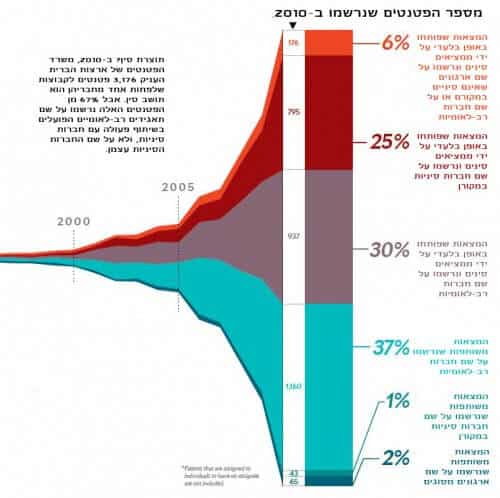Why the dizzying increase in the number of international patents originating in China signals the emergence of a new, international type of research and development

Countries usually do not start creating unprecedented innovative technology before they reach economic prosperity - more precisely, before their GDP and per capita income approach those of the richest countries in the world. China is still a fairly poor country. Until recently, back in 2010, its per capita income was one-tenth smaller than that of the United States. However, according to official data, Chinese companies increased spending on research and development by 26.2% per year between 1996 and 2010. The number of patents the US Patent Office alone granted to Chinese inventors increased by 4,628% from 1996 to 2010. What's going on here?
A closer examination of these patent filings shows that multinational corporations, rather than Chinese companies, hold most of the patents registered in the US in this surge of filings. That is, the Chinese companies themselves still lag behind their multinational competitors in issuing inventions that are registered as patents in the developed countries of the world.
The situation in China is unusual compared to that of other growing economies in Asia. From the day Japanese, Taiwanese and South Korean companies began to emerge as important centers of innovation, almost all patents granted in the US to inventors from these countries were the result of the labor of and owned by companies from those countries. In China, things turned out differently for several reasons. First, China opened its borders to foreign companies more fully, and it did so at an earlier stage of its economic development than its neighbors. Second, China's vast territory and rapid growth have motivated multinational companies to establish research and development centers there in due course to ensure their success in this growing key market. Third, the Internet has allowed engineers based in China to collaborate on research projects, almost in real time, with colleagues from all over the world. This combination of circumstances allowed for close research interactions between Chinese R&D personnel and their counterparts elsewhere, more so than was possible when Taiwan and South Korea were developing their invention-rich economies.
In the research we did, we saw how this direct international interaction was reflected in the patent documents themselves. Most of the patents originating in China and registered in the US in the name of multinational corporations were, in fact, developed by international teams of inventors, some of whose members do not live in China at all. We call this phenomenon "international joint invention", and it also characterizes the patents granted to Chinese inventors by the EU Patent Office.
The international joint invention is not only about adapting existing technologies to the needs of the Chinese market. Many multinational corporations today allocate a significant part of their research manpower in China to the development of new technologies for markets all over the world. In fact, this research collaboration, which is becoming more and more common between countries, is to the benefit of all parties involved. China gains access to western technologies that have them to answer the needs of the Chinese people. And the entire world benefits from the influx of inventions created by the winning combination of China's raw engineering talent and multinational research and development expertise.
Currently, unfortunately, other aspects of China's business environment are cooling the enthusiasm of foreign multinational corporations. Managers in such corporations complain about the violation of patent rights and the theft of trade secrets. There have even been cases in which the Chinese government and Chinese companies owned by the government or operating under government sponsorship pressured multinational corporations to hand over sensitive technologies to Chinese "partners" with whom they do not have official trade relations.
Still, one can already see signs that the international joint invention is becoming widespread in India and Eastern Europe as well and not only in China. This phenomenon is a sign of something new in the world: an international division of research and development that links skilled engineers in developing economies with the technological expertise of established multinational corporations. This is a welcome development. And in fact, it may even be necessary to deal with the enormous technological challenges facing humanity in the 21st century.
_______________________________________________________________________________________________________________________________________________________________
About the authors
Lee Branstetter is an associate professor of economics and public policy at Carnegie Mellon University. Gongwai Li (Li) is a doctoral student at Heinz College at Carnegie Mellon University. Francisco Veloso is a professor in the Faculty of Engineering and Public Policy at Carnegie Mellon University and Dean of the Católica Lisbon School of Business and Economics in Portugal.
More on the subject
China's Embrace of Globalization. Lee Branstetter and Nicholas Lardy. July 2006. www.heinz.cmu.edu/research/352full.pdf
The Globalization of R&D: China, India, and the Rise of International Co-invention. Lee Branstetter, Guangwei Li and Francisco Veloso. August 2013. http://heinz.cmu.edu/global_research
The article was published with the permission of Scientific American Israel

One response
Investing in R&D (research and development) is the smartest move by the Chinese. Because it is difficult to stay at the wage levels of textile and construction activity, it is difficult to raise wages. If America wants to beat the Chinese economy, they need to invest in R&D, and not maintain zero interest rates.